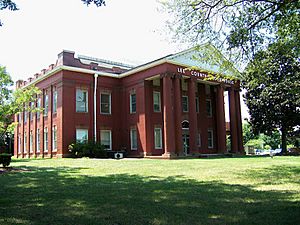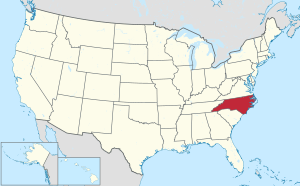Lee County, North Carolina facts for kids
Quick facts for kids
Lee County
|
|||
|---|---|---|---|

Lee County Courthouse
|
|||
|
|||
| Motto(s):
"Committed Today for a Better Tomorrow"
|
|||

Location within the U.S. state of North Carolina
|
|||
 North Carolina's location within the U.S. |
|||
| Country | |||
| State | |||
| Founded | April 1, 1908 | ||
| Named for | Robert E. Lee | ||
| Seat | Sanford | ||
| Largest community | Sanford | ||
| Area | |||
| • Total | 259.20 sq mi (671.3 km2) | ||
| • Land | 255.06 sq mi (660.6 km2) | ||
| • Water | 4.14 sq mi (10.7 km2) 1.60% | ||
| Population
(2020)
|
|||
| • Total | 63,285 | ||
| • Estimate
(2023)
|
67,059 | ||
| • Density | 281.2/sq mi (108.6/km2) | ||
| Time zone | UTC−5 (Eastern) | ||
| • Summer (DST) | UTC−4 (EDT) | ||
| Congressional district | 9th | ||
Lee County is a county located in the U.S. state of North Carolina. As of the 2020 census, the population was 63,285. The county seat is Sanford.
Lee County comprises the Sanford, NC Micropolitan Statistical Area, which is a part of the Raleigh-Durham-Cary, NC Combined Statistical Area, which had an estimated population of 2,368,947 in 2023.
Contents
History
The nature of Native American habitation of the land eventually comprising Lee County is not well known. People of European and African descent settled in the area in the 1740s and 1750s. In the 1850s, the state's first commercial coal mine opened in the community of Egypt. During the American Civil War, the area supplied coal and iron to the forces of the Confederate States of America.
In 1907, residents of the city of Sanford of Moore County beginning pushing for the creation of a new county to ease the burden of their travel to Moore's seat of Carthage. The North Carolina General Assembly passed a law creating Lee County from portions of Moore and Chatham counties effective April 1, 1908 pending ratification in a plebiscite by the people living in the proposed county. The referendum was held on July 1, with voters approving the new county 875 to 40. County officials were installed on February 17, 1908. The county courthouse was erected on a site between Sanford and Jonesboro and occupied by county officers in early March 1909.
Lee County's population and economy steadily grew after its creation, fueled by the success of tobacco, furniture, quarrying, brickmaking, and textile industries. In 1947, the cities of Sanford and Jonesboro merged.
Geography
According to the U.S. Census Bureau, the county has a total area of 259.20 square miles (671.3 km2), of which 255.06 square miles (660.6 km2) is land and 4.14 square miles (10.7 km2) (1.60%) is water.
State and local protected areas
- Lee Game Land (part)
- White Pines Nature Preserve (part)
Major water bodies
- Big Governors Creek
- Cape Fear River
- Cypress Creek
- Deep River
- Juniper Creek
- Lake Trace
- Lake Villanow
- Lick Creek
- Little Buffalo Creek
- Little Governors Creek
- Little Pocket Creek
- Pocket Creek
- Roberts Creek
Adjacent counties
- Chatham County – north
- Harnett County – southeast
- Moore County – southwest
Major highways



 Future I-685
Future I-685 US 1
US 1 US 15
US 15 US 421
US 421


 US 421 Bus.
US 421 Bus. US 501
US 501 NC 42
NC 42 NC 78
NC 78 NC 87
NC 87
 NC 87 Byp.
NC 87 Byp.
Major infrastructure
- Raleigh Executive Jetport
Demographics
| Historical population | |||
|---|---|---|---|
| Census | Pop. | %± | |
| 1910 | 11,376 | — | |
| 1920 | 13,400 | 17.8% | |
| 1930 | 16,996 | 26.8% | |
| 1940 | 18,743 | 10.3% | |
| 1950 | 23,522 | 25.5% | |
| 1960 | 26,561 | 12.9% | |
| 1970 | 30,467 | 14.7% | |
| 1980 | 36,718 | 20.5% | |
| 1990 | 41,374 | 12.7% | |
| 2000 | 49,040 | 18.5% | |
| 2010 | 57,866 | 18.0% | |
| 2020 | 63,285 | 9.4% | |
| 2023 (est.) | 67,059 | 15.9% | |
| U.S. Decennial Census 1790–1960 1900–1990 1990–2000 2010 2020 |
|||
2020 census
| Race | Number | Percentage |
|---|---|---|
| White (non-Hispanic) | 36,055 | 56.97% |
| Black or African American (non-Hispanic) | 10,701 | 16.91% |
| Native American | 231 | 0.37% |
| Asian | 643 | 1.02% |
| Pacific Islander | 43 | 0.07% |
| Other/Mixed | 2,490 | 3.93% |
| Hispanic or Latino | 13,122 | 20.73% |
As of the 2020 census, there were 63,285 people, 21,894 households, and 15,223 families residing in the county.
Communities
City
- Sanford (county seat and largest community)
Town
Unincorporated communities
- Blacknel
- Colon
- Cumnock
- Lemon Springs
- Murchisontown
- Osgood
- Swann Station
- Tramway
- White Hill
Townships
The county is divided into seven townships, which are both numbered and named:
- 1 (Greenwood)
- 2 (Jonesboro)
- 3 (Cape Fear)
- 4 (Deep River)
- 5 (East Sanford)
- 6 (West Sanford)
- 7 (Pocket)
Education
There is one school district, Lee County Schools.
Trivia
- The area has historically been one of the leading brick manufacturing areas in the United States.
- Cotton and tobacco are leading crops in the county.
- The county is divided between the Piedmont in the northern part of the county and the Sandhills in the south.
- Lee County sits in the middle of the Triassic Basin and has the state's most concentrated reserves of oil and natural gas.
- Lee County is also home to the longest covered bridge in North Carolina found along NC 42 near Ole Gilliam Mill Park.
See also
 In Spanish: Condado de Lee (Carolina del Norte) para niños
In Spanish: Condado de Lee (Carolina del Norte) para niños




